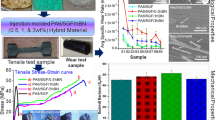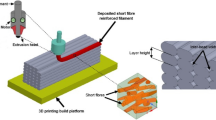Abstract
This paper reports mechanical property measurements for Portland Cement paste free from fabrication artifacts (e.g. bubble-type voids), and compares them to published results both for normal and new high strength cement. Removal of large voids (above 100μm) by vacuum de-airing leads to an increase of ∼ 15% in mean flexural strength and a small decrease in fracture toughness. This increase in flexural strength is predictable from the tied-crack model previously proposed to explain the notch-sensitivity behaviour of hardened cement paste, and for which direct experimental evidence was obtained. It is suggested that factors such as moisture content are at least as important as large voids in controlling mechanical properties. It is concluded that the much increased strength of the new polymer-containing cements must result from improvements to the microstructure other than the simple elimination of voids.
Similar content being viewed by others
References
J. D. Birchall, A. J. Howard andK. Kendall,Nature 289 (1981) 388.
J. E. Bailey andD. D. Higgins,Nature 292 (1981) 89.
J. D. Birchall, A. J. Howard andK. Kendall,ibid. 292 (1981) 89.
D. D. Higgins andJ. E. Bailey,J. Mater. Sci. 11 (1976) 1995.
Idem, Conference on Hydraulic Cement Pastes, Sheffield, Cement and Concrete Association, UK, 1976, 283–96.
N. McN. Alford,Cem. Concr. Res. 11 (1981) 605.
N. McN. Alford, G. W. Groves andD. D. Double,ibid. 12 (1982) 349.
J. D. Birchall, A. J. Howard andK. Kendall,J. Mater. Sci. Lett. 1 (1982) 125.
Idem, in “Engineering with Ceramics”, Proceedings of the British Ceramic Society No. 32, edited by R. W. Davidge (1982) pp. 25–32.
Idem, Chem. Britain 18 (1982) 860.
R. A. Helmuth andD. H. Turk, in “Structure of Portland Cement Paste and Concrete”, (SP90, Highways Research Board, 1966) pp. 135–44.
M. Yudenfreund, I. Odler andS. BrunAuer,Cem. Concr. Res. 2 (1972) 313.
S. Timoshenko, “Strength of Materials” (Van Nostrand, London, 1938).
N. F. Brown andJ. E. Srawley, ASTM STP 410 (American Society for Testing and Materials, Philadelphia, 1967).
K. Watson,Cem. Concr. Res. 8 (1978) 651.
K. M. Alexander,Nature 183 (1959) 885.
J. D. Birchall, A. J. Howard andK. Kendall, UK Patent Application Nos. 8041640 (1980) and 8123103 (1981).
Author information
Authors and Affiliations
Rights and permissions
About this article
Cite this article
Eden, N.B., Bailey, J.E. On the factors affecting strength of portland cement. J Mater Sci 19, 150–158 (1984). https://doi.org/10.1007/BF02403121
Received:
Accepted:
Issue Date:
DOI: https://doi.org/10.1007/BF02403121




